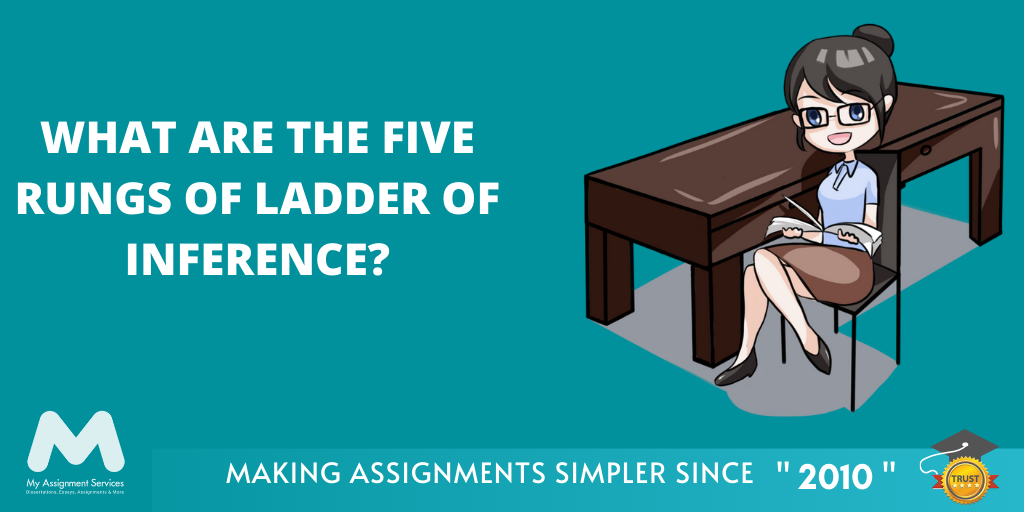
The Ladder of Inference is a cognitive tool used to help understand how we naturally arrive at conclusions or make decisions given incomplete and inaccurate information. This can be useful when trying to determine why someone has come to a certain conclusion, even if they seem unsure about the reasons why, or might not even realise that their reasoning process contains logical fallacies or factual inaccuracies. Using the ladder and understanding our own (and others') natural decision-making processes, we can better determine what accurate inferences should be drawn from the available evidence and where errors may have been made in reaching an incorrect or less than an optimal conclusion. The Ladder of Inference was developed by Chris Argyris at Harvard University during his work with Peter Senge on Organisational Learning and is often taught as part of the Systems Thinking process tools.
The Ladder describes how people arrive at conclusions by moving up a series of five logical "steps". Each step of the ladder builds upon the prior rung so that misperceptions at one level are passed to the next for refinement until an actionable decision can be made. The Ladder shows how what we know (and think we know) drives our decisions; however, these ideas may not always be accurate or factual due to faulty information or reasoning. Our beliefs (what we think) drive our interpretations (how we see things), which then determine our Behaviours (what we do). all behaviour can be traced back to a thought which can be traced back to a belief. Now let's see a description overview of the ladder of inference - theory and example.

Our interpretation of a given situation or information can be based on past experience, facts that we know to be true, feelings and emotions about the subject at hand (or other factors), which then influence our beliefs. For example, if you see your neighbour's car in front of your house after work, your first thought might be that they're visiting. If you believe them to be divorced with no children living at home, this will lead you to the belief that something bad must have happened - perhaps one of their parents has died, or someone is sick. Interpretation (observations) drive Beliefs (conclusions).
These are often "self-talk" statements that explain our beliefs and drive our interpretations. For example, if you believe that your neighbour's visit is due to the death of their parents, this might lead to thoughts such as "how sad" or "I should send my condolences." These thoughts would then influence your feelings towards the situation - perhaps you feel sad for them or be suspicious because they've never visited before. Thoughts (self-talk) drive Feelings.
At this point in the Ladder, how we see something has already been influenced by our Beliefs and Thoughts, which have in turn shaped our interpretation of a situation. If we see someone crying on the sidewalk down the street from where we live, our interpretation could be influenced by our thoughts and feelings, such as "Maybe they just had a fight with their significant other," or "That's so sad - I feel so bad for them." Our interpretation of this situation could then influence what we do next. Perhaps we go over to see if they're okay, call 911, avoid passing by in our car out of fear that something bad has happened or that the person is dangerous, or ignore them altogether, thinking that there's no way we can help and it's not our business anyway. Interpretation (beliefs) drive behaviour (action).
At this point in the Ladder, how someone sees themselves and their own role in a given situation will drive their behaviour. For example, if you interpret someone in distress on the sidewalk down the street from where you live as needing help, your beliefs could lead to actions meant to benefit them or avoid harm. You might drive to a nearby convenience store and buy some chocolate for them, or go over and ask if they're okay, call 911 because you think something bad has happened, or just avoid passing by altogether out of fear that they might hurt you. Beliefs (recognition) drive behaviour (action).
This rung is all about observable outcomes - what happens when we act. Our interpretations and beliefs will influence the outcomes observed but may not always match our expectations. For example, you might drive to the convenience store and buy some chocolate for someone who appears to be in distress on the sidewalk, go over and ask if they're okay, call 911 because you think something bad has happened, or avoid them altogether out of fear. Regardless of what happens next, your actions will positively or negatively affect the situation due to your interpretation/beliefs.

Whether we realise it or not, all behaviour can be traced back to a thought which can be traced back to a belief. The way we see things - our interpretation of a given situation or information - determines how we feel about that thing (our feelings), then this drives our thoughts and ultimately influences our actions. In turn, our behaviour determines the outcome of a given situation or event, which will lead us to form new beliefs. Over time, this process of forming beliefs through our interpretation of events and the resulting actions we take based on those beliefs will either confirm or disprove our initial thoughts. Thus, the way we see things will ultimately drive how we feel about them (our feelings), which will influence what we think (our thoughts), then these thoughts will influence what we do (our behaviour) - which in turn leads to new beliefs.
Marketers can use the Ladder of Perception to understand consumer behaviour choices and market to consumers most likely to buy their products, by therapists, pastors, spiritual leaders, counsellors, teachers, parents, managers, coaches... really anyone who works with people! It's also a great tool for self-awareness. The more aware we are of our thoughts and feelings' influence on our behaviour, the more control we can gain over our lives. The Ladder of Perception is one way to achieve that. Suppose you're interested in increasing your personal awareness and understanding of the choices people make, especially when it comes to how they spend their money. In that case, The Ladder of Perception can be a great tool.
Give your marketing strategy a boost by using the Ladder of Perception to help understand consumer behaviour choices. The more aware we are about our thoughts and feelings, the better equipped we will be in making decisions that lead us to success. Don't worry if you're not sure how to use the ladder or need some assistance with it. Experts at My Assignment Services will give that to you. Enrol in our 1:1 session and clear all your academic woes and assignment doubts! Fill the form now!

Bill is an academic expert in the fields of law, nursing, business, and management. His diligence in editing and writing assignments solutions has been applauded by students from around the globe; who swear by his eclectic writing style and subject matter expertise in Law and Nursing Studies. He is full time associated with My Assignment Services as a Senior Academic Writer and loves binge-watching on anything sci-fi.
1,212,718Orders
4.9/5Rating
5,063Experts
Bonanza Offer
Get 40% Off *
on your assignment today
Trending now
The Student Corner
Subscribe to get updates, offers and assignment tips right in your inbox.
Popular Posts
Popular Posts
Doing your Assignment with our samples is simple, take Expert assistance to ensure HD Grades. Here you Go....
Loved reading this Blog? Share your valuable thoughts in the comment section.
Add comment